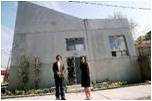Building an Eco-Friendly Home on a Budget
by Cynthia Booth
(ArchitectureCareers.Org)
New Jersey college of architecture professor illustrates us how to construct an environmental-friendly residence on a tight budget.
Are you aware that 2 New York based designers designed an asymmetrical home with fixed cost of $250,000?
Designers and Jersey City residents Richard Garber (assistant professor at NJ Institute of Technology’s College of Architecture and Design in Newark) and Nicole Robertson of GRO Architects in NYC rose to the difficult task of designing and managing the construction of a single-family house that’s a real proof of both revolutionary design and eco-friendly technologies.
Denis Carpenter not too long ago purchased one small vacant lot and, to achieve his interest for the environment, desired a house that was efficient and easy to maintain.
What's so exceptional about this home?
- In the home, on the ground level, radiant heating below the exposed cement floor heats up the full bathroom and a couple of bedrooms.
- In the loft-like 2nd level, sleek aluminum and stainless steel railings accent the bamboo stairway to the mezzanine, living room and an artfully designed kitchen outfitted with salvaged appliances and cabinetry.
- Passive air conditioning strategies like ceiling fans and clerestory windows permit owners to remain cool during summer months and hot during winter.
- The roof contains 260 sq ft of solar panels that produce nearly 2,000 kilowatts of energy each year to a battery stored in the basement.
- The root have a 2-foot-square area planted with drought-resist to collect rain .
This single family 1,600-square-foot home was created in six months and won a 2009 American Institute of Architects merit award and the 2010 Green Building of the Year Award from the Jersey City Redevelopment Agency.
So what now? How can you convert your home into an environmentally-friendly home without paying too much funds?
If you're remodeling a home, perform an energy review first to help you figure out what energy efficiency developments should and can be made to your home. In this way you'll calculate how much energy your home consumes.
My personal favorite eco-friendly technique is the passive solar cooling/heating design.
Passive solar indicates that your home's windows, walls, and floors can be made to collect, store, and distribute solar energy in the form of heat in the winter season and reject solar heat in the summer season.
Existing buildings can be adapted or "retrofitted" to passively collect and store solar heat too.
The following 5 factors constitute a comprehensive passive solar home design:
The Collector - The area through which sunlight enters the building (usually windows).
The Absorber - The hard, darkened surface of the storage element. Sunlight hits the surface and is absorbed as heat.
The Thermal Mass - The elements that retain or store the heat produced by sunlight below or behind the absorber surface.
The Distributor - The system by which solar heat circulates from the collection and storage points to different areas of the house.
The Controller - Roof overhangs may be used to shade the aperture area during warm weather or Thermostats that signal a fan to turn on.
About the writer - Cynthia Booth contributes articles for the www.architecturecareers.org. It's a nonprofit internet site dedicated to provide help for young architects who need resources for their careers. With this she would like to raise the interest on eco-friendly home design and change the general public perception of energy efficiency.


